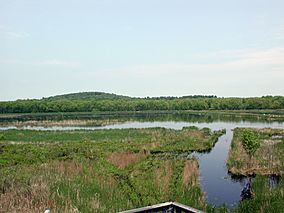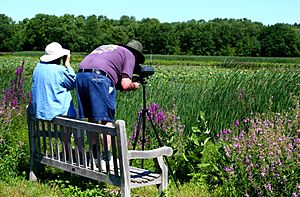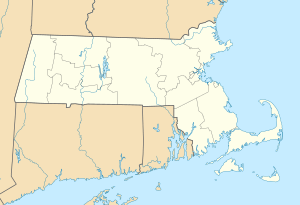Great Meadows National Wildlife Refuge facts for kids
Quick facts for kids Great Meadows National Wildlife Refuge |
|
|---|---|
|
IUCN Category IV (Habitat/Species Management Area)
|
|

View of Great Meadows, Concord
|
|
| Location | Concord, Massachusetts, Sudbury, Massachusetts, United States |
| Nearest city | Concord, Massachusetts |
| Area | 250 acres (100 ha) |
| Established | 1944 |
| Governing body | U.S. Fish and Wildlife Service |
| Website | Great Meadows National Wildlife Refuge |
The Great Meadows National Wildlife Refuge is a special place for nature. It protects a long area of wetlands, which are like watery lands. This refuge stretches about 12 miles (19 km) along the Concord River and Sudbury River in Massachusetts.
It is part of the National Wildlife Refuge system. This means it is a protected area managed by the U.S. government. The refuge is a very popular spot for people who love to watch birds. It is also great for anyone who enjoys nature. About 85% of the refuge's 3,600 acres (14.6 km²) are freshwater wetlands. These wetlands are important homes for many plants and animals.
Contents
A Look Back: How Great Meadows Began
The first part of the refuge was a 250-acre (1 km²) area in Concord, Massachusetts. People have called this area the "Great Meadows" since the 1600s.
In 1944, a man named Samuel Hoar donated this land to the U.S. government. He was a resident of Concord. Mr. Hoar had bought part of the Meadows in 1928. He built earthen walls, called dikes, to keep water in the marshlands. This made the area even better for waterfowl, which are birds that live near water. The U.S. Fish and Wildlife Service started buying more land in the 1960s. This helped to protect the wetlands and wildlife even more.
Amazing Animals and Birds
The Great Meadows refuge is home to many different kinds of birds. You can see nesting waterfowl like mallards and wood ducks. There are also black ducks and blue-winged teal.
Many other animals live here too. You might spot white-tailed deer or muskrats. Red foxes, raccoons, and cottontail rabbits are common. Look out for weasels, beaver, and squirrels. In warmer months, many kinds of amphibians and reptiles are active.
The Concord part of the refuge has two small lakes. These are called "pools" or "impoundments." Every summer, the water from these pools drains into the Concord River. This creates muddy areas called mudflats. These mudflats are perfect feeding spots for many shore birds and waterfowl. These birds stop here during their migration in late summer.
In late July and August, you can see many birds feeding here. This includes different types of sandpipers and killdeer. You might also see lesser and greater yellowlegs, and great egrets. Large groups of great blue herons, ducks, and Canada geese also come to these muddy, food-rich areas.
Visiting Great Meadows

The Sudbury part of the refuge has the main office and a visitor center. It is located in Sudbury, Massachusetts. This center is open on weekdays.
The Concord part of the refuge is open every day from dawn until dusk. It has about 2.7 miles (4.3 km) of trails. These trails are great for walking and exploring nature.
Images for kids



